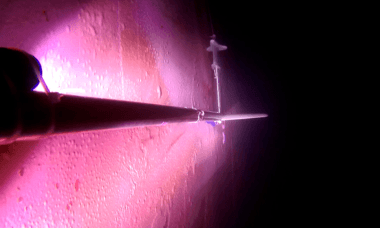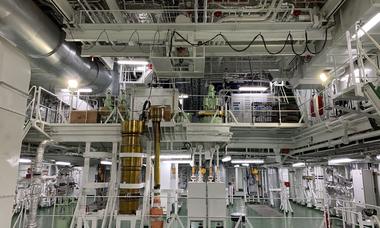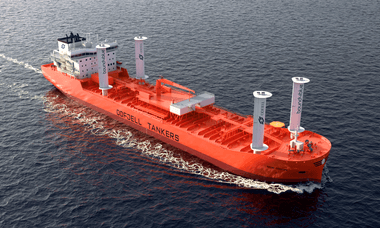The below is a translated version of an article on rederi.no – The Norwegian Shipowners’ Association,
published on Octover 12, 2023. Written by Håvard Solerød. Read Norwegian original here.
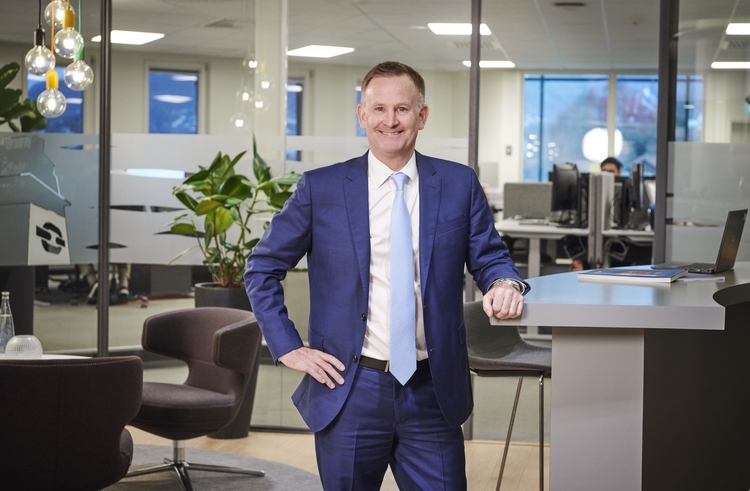
"As an architect, you have to sell something that does not exist yet and think holistically. In my mind, I am still an architect, even though I have been the Chair of Odfjell since 2010." The Yale University-educated architect brings his creative skills and holistic thinking to the maritime sector.
We met him in Singapore the same week he participated in a conference on environmental issues, shipping, and the future.
"What I took away from the debate was that everyone is moving in the same direction. Even though it's encouraging to see this wave gaining momentum, there was nothing new to report. The concepts presented for future maritime fuels lack holistic considerations," he says.
Chemicals, bees, and wine
Odfjell has a rich history, dating back to 1914 when it all began with a single ship. Today, Odfjell stands as a publicly listed company with 2,300 employees, boasting a fleet of 70 chemical tankers. Odfjell also has sizeable ownership stakes in four tank terminals; two in the USA, one in Belgium, and one in South Korea.
Looking back on his upbringing, Laurence remembers his father's dedication to expanding Odfjell into one of the world's leading players in chemical transport. He was the first to introduce stainless steel tanks for transporting chemicals in 1960.
A strong competitor and rival in the same segment was the shipping company Stolt-Nielsen. The rivalry between these two Norwegian shipowners was defined by their goals to be the first and largest, exhibiting their persistence as industry builders, says Laurence about his father's generation.
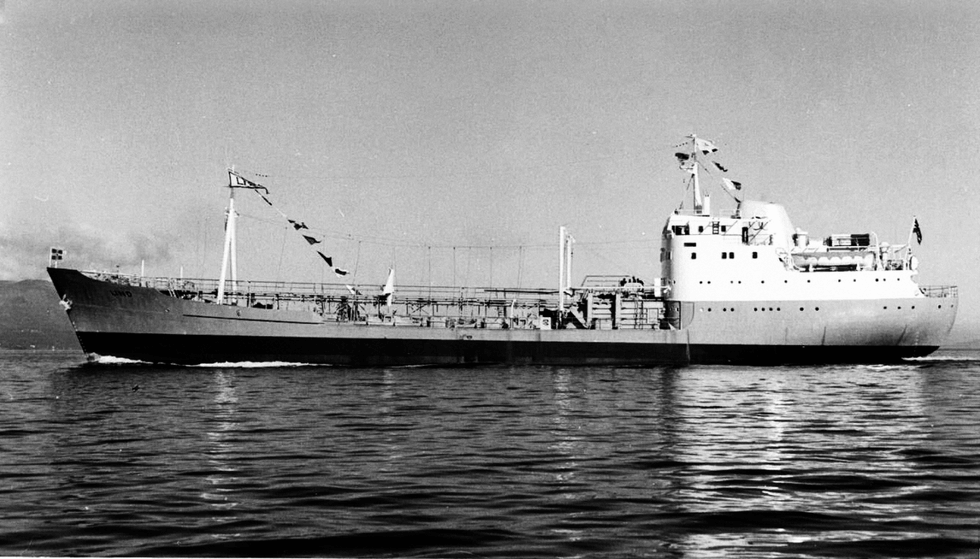
MC Lind, the world's first stainless steel tanker, delivered to Odfjell in 1960
During his early years, Laurence couldn't help but observe the challenges and pressures his father faced while building Odfjell into a major player in the chemical transport industry.
"It didn't seem like my father was having much fun. The company was also in a tough pioneering and building phase," Laurence recalls. Today, with Odfjell operating as an established and efficient company, Laurence feels fortunate to have a smoother journey than his father.
Growing up in a household with four siblings, the Odfjell family's dynamic was characterized by structure and discipline. "We were four children at the dinner table. We weren't allowed to speak unless spoken to first. Father was often exhausted and didn’t appreciate noise," says Laurence.
Despite his family's close ties to the shipping industry, Laurence initially didn’t even consider a job in the company. Instead, he followed his own path and pursued architecture as his calling.
Unexpectedly, it was beekeeping that eventually led him to join the family business.
"My grandfather led the business through World War II. Even for a prosperous shipping family, securing enough food on the table during the war was no easy task. In the midst of those trying times, he began beekeeping in the garden, sparking a fascination that was passed down to his son, my father. The passion for beekeeping is still burning strong in my father, even now in his 80s," says Laurence.
Both his grandfather and father have been significant sources of inspiration for Laurence. "Grandfather was very correct and excellent with numbers. An decent shipowner in every way. He was more formal than my father, who is more outgoing, innovative, and commercial."
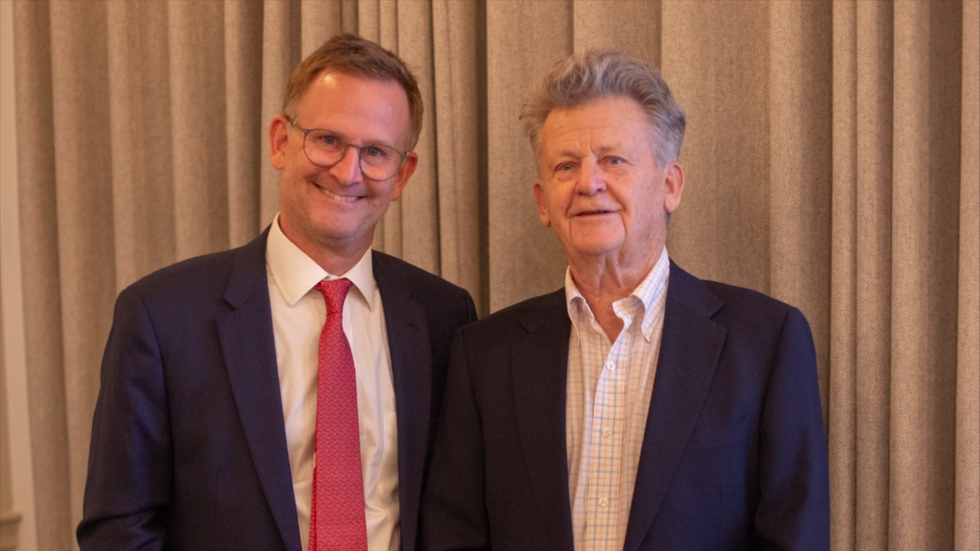
Laurence and his father Dan Odfjell. Photo: Anne Helstein
"The allure of fruit trees and the process of pollination brought immense joy to my father. In Norway, though, acquiring a farm was no easy feat, often requiring marriage to an heir for such an opportunity. Luckily the shipping company had operations in Chile. That's how he ended up buying a fruit farm there," Laurence explains.
Running a fruit farm in Chile proved more challenging than expected, and after some years his father decided to venture into wine production. Laurence was tasked with designing the new winery.
"I was the architect, and my father was the client. It was great fun. For the first time, we worked together and got to know each other better," says Laurence.
When the vineyard was completed in 1998, his father said, "Laurence, you could do well in terminals and shipping. You are welcome to join anytime you want."
"But at that time, I had just been commissioned to design two vineyards for the American wine producer Kendall-Jackson in Chile and Argentina, so I had to decline," Laurence explains. These projects were ambitious collaborations involving Chileans, Argentinians, and Americans, requiring meticulous consideration of various factors.
"Although the projects were successes and we delivered on time for harvest, I was exhausted and burnt out by the time the wine facilities were completed. I called my father and asked if his offer to join the family business was still open. He said yes.”
“In 2000, Odfjell merged with the shipping company Seachem, which was controlled by Peter Livanos, becoming the world's largest chemical shipping company," says Laurence.
Laurence started working at the terminal in Chile the same year, and he joined Odfjell’s board for the first time in 2004. "After a while of working at Odfjell’s terminals in Chile and Brazil, Peter Livanos, who was on the Odfjell board at the time, said 'you're wasting your time there. Go to Singapore, work at our office, and learn about shipping.' It was sound advice and the start of a journey that culminated in my appointment as chair of Odfjell SE in 2010."
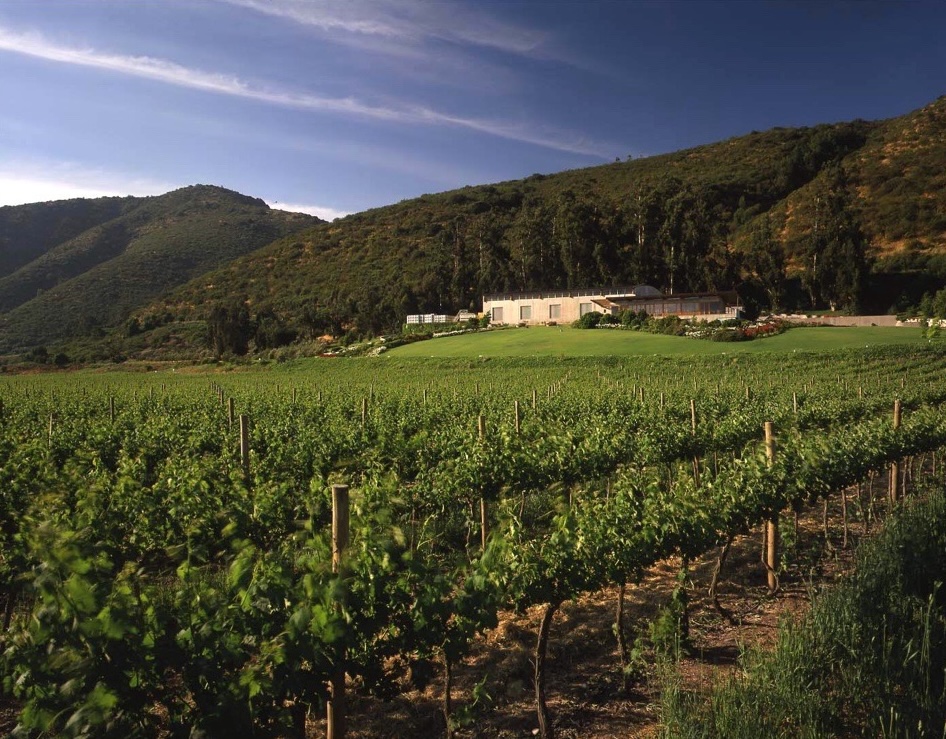
Odfjell's Vineyard in Chile
Laurence still finds it surreal that they own a vineyard in Chile. The Odfjell wines can be found on the wine lists of Michelin-starred restaurants in Singapore and at the state liquor store in Norway, as well as on shelves and winelists in many parts of the world.
“We have been losing money on the vineyard for years – although just before the outbreak of Covid, there were prospects of breakeven results for the first time. In any case, I am proud of our wine production.”
“Our wines are organic and biodynamic. We care about clean air and clean water. It is also in our Norwegian spirit to do so.”
Implications of the pandemic
Laurence's mother is from Missouri, USA. He grew up in a bilingual household in Bergen. Since the 1980s, he has lived outside Norway's borders, and his current base is in Singapore.
Before the pandemic, slightly less than half of Odfjell's chemical tankers were registered under the Singapore flag, while the remainder carried the Norwegian flag.
"Having the Norwegian flag on the stern during Covid was a mark of quality. The Maritime Directorate, the civil service, and the Norwegian Shipowners' Association all collaborated and did a tremendous job for the welfare of the seafarers. They provided care and did their best to assist them.”
“The Maritime Directorate also granted exemptions, provided a solid plan was presented in case someone was infected on board or during crew changes,” says Laurence.
"However, we experienced that Singapore Maritime Authorities didn't respond as expected to the Norwegian flag. Under Covid, there was no help to be found to solve helping our seafarers on and off ships. The seafarers are our colleagues at sea. They should be treated with respect and given the help they need. Therefore, we decided to reflag our ships. Several of our Singapore flagged ships were added to the NIS register after the pandemic, while a minority were registered in the Marshall Islands.”
The choice of the Marshall Islands was based on Odfjell’s observation that their voting behavior within the IMO was consistent with Norwegian values. "The islands are vulnerable to rising sea levels, and they often vote in agreement with Norway on climate issues," says Laurence.
Looking towards 2050
In December of last year, the International Maritime Organization (IMO) asked Odfjell to present what the company is doing to reduce emissions from its fleet. Laurence attributes the company’s competitive advantage to the expertise of Odfjell's team.
"As an example of our leadership position, we were the first shipping company in the world to issue sustainability-linked bonds. We report very transparently to show our progress to reduce emissions. This way, we hope to encourage others as well. Analysts can now inquire about carbon intensity, and they have already begun doing so. This will demonstrate our competitiveness.”
“To increase our customers' awareness of emissions, we send them an email when their cargo is delivered in port, informing them how much CO2 their cargo accounted for on this voyage. Next year, they will in addition receive a carbon tax invoice at the conclusion of the trip if cargo is loaded or discharged in Europe.”
According to the IMO's Carbon Intensity Index, Odfjell's ship emissions have already decreased by 51% between 2008 and the first quarter of 2023.
"It should be noted that we have reduced the quantity of smaller ships in favor of larger ones, resulting in lower emissions per cargo. Adjusting for this, the percentage is approximately 35%, which is still excellent," Laurence remarks.
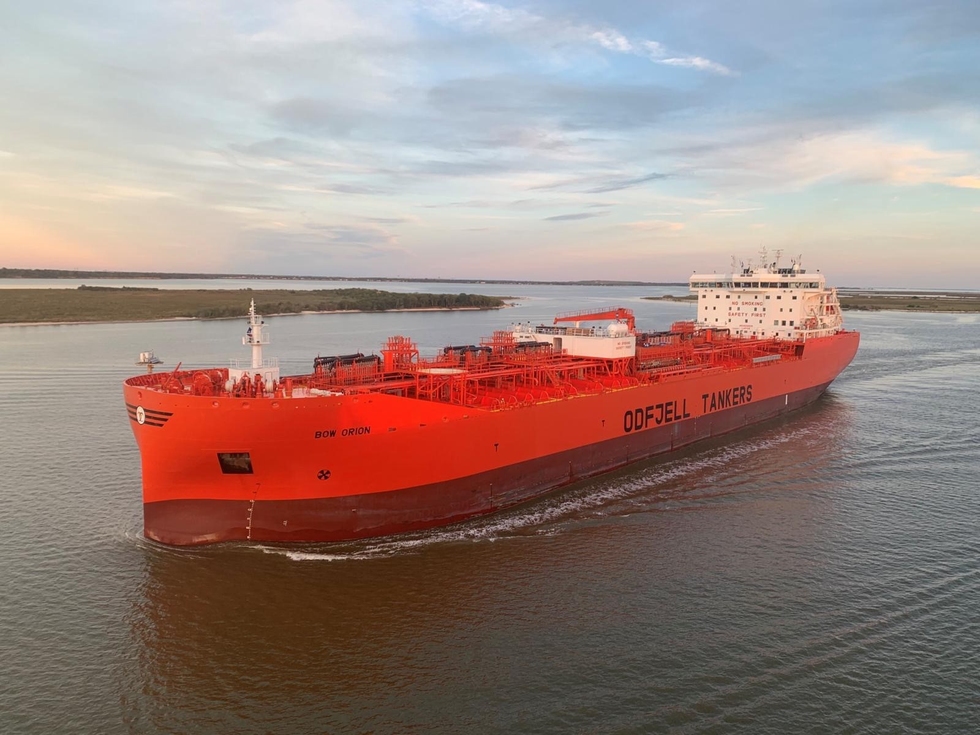
Bow Orion, one of Odfjell's largest chemical tankers
The Odfjell team and Chair are confident that two fundamental tenets will manifest in the future:
"Our primary objective is to enhance the efficiency of existing technology and systems, as this is already profitable and environmentally beneficial. The second objective is to be sufficiently flexible when it comes to the future of fuels.”
Laurence emphasizes the importance of flexibility and ensuring that all new ships can utilize multiple fuels. He advocates for fact-based analyses in discussions about the green shift, and Odfjell has invested resources to achieve this goal.
"What does it really mean to use green methanol and green ammonia as fuel? For example, with fuel cells and ammonia as propulsion, the emissions from the ship are water, but how much electricity is needed to produce green ammonia? If you work backward, there’s a huge leap. If the electricity used in the production is generated using coal-fired power plants, total CO2 emissions increase. The emissions are just moved elsewhere.”
"Our calculation shows that to have the sufficient electricity needed to produce green methanol from electricity, based on today's merchant fleet, we would need 750 nuclear power plants. Who will build 750 nuclear power plants in the next 10-20 years for the fuel to be used on ships? Nobody. I'm not saying this to dampen the work being done, but we have much more belief in the importance of working on the efficiency of existing systems at this stage," states Laurence.
He encourages electricity producers to take part in the debate on future fuels.
New ship on the drawing board
Fuel cells and nuclear power are subjects that personally intrigue Laurence. His involvement in exploring future fuels and optimizing current systems has evolved into a genuine passion.
Prioritizing environmental considerations is not only essential for sustainability but also advantageous for business. Implementing weather routing, digital management, continuous hull cleaning, introducing new propellers, and more have collectively contributed to a positive impact on Odfjell's financial performance.
"As an example, we invested a million dollars per ship in upgrades to enhance efficiency. These investments have proven worthwhile, generating paybacks in just over a year and continuing to yield returns," says Laurence.
"We are currently developing the next generation of ships, and the concept is nearing completion. However, the specifics remain confidential at this stage.”
He can reveal, though, that “we have received 400 suggestions for improvements from within our organization, including valuable input from seafarers, operators, charterers, and the technical department. Our trademark is being solution-oriented, and the new design will reflect that.”
The timing for the maiden voyage is not clear yet. “The current situation with shipyards and prices has put the order on hold. I look forward to seeing the new concept become a reality."
Next generation
In his leisure time in Singapore, Laurence finds relaxation in sports, although he admits to being a latecomer to golf and still finding his way.
"I started golfing late and am pretty hopeless. It takes time to become good, but you compete with yourself, so it doesn't matter."
Being part of a close-knit family, Laurence takes pride in involving the next generation in the family business. One of his nephews works as a trainee for the company in Singapore, and a niece has also worked there for a period. Once a year, all the children in the family over the age of 16 are invited to a family gathering in cities within their network.
"Eight are coming this time. We inform them about the shipping and terminal activities of the company and discuss various issues. This is how we familiarize the next generation with the business and perhaps spark their interest," says Laurence.
Laurence’s youngest is only nine years old and attends school in Singapore.
"He is a blessing who arrived late in life. You see the world with fresh eyes and enjoy the excitement of your child's discoveries — so many 'wows'! I'm inspired by the ideas the children represent in terms of human rights, equality, and the environment. It gives me hope for the future and a sense of "wow" as well," Laurence concludes.
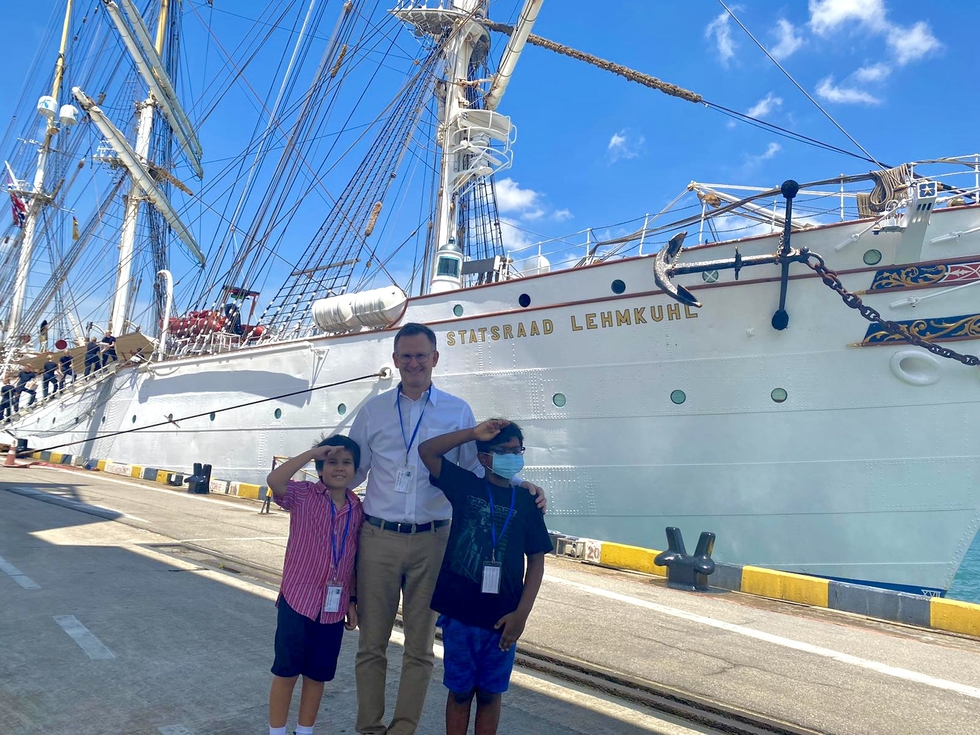
Laurence together with his son and his friend, visiting the Norwegian barque Statsraad Lehmkuhl when it called Singapore as part of it's recent circumnavigation.
Read the Norwegian article on rederi.no: – Energieffektivisering er viktigst nå
